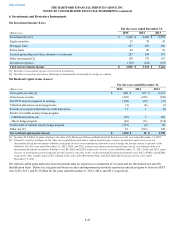The Hartford 2015 Annual Report Download - page 184
Download and view the complete annual report
Please find page 184 of the 2015 The Hartford annual report below. You can navigate through the pages in the report by either clicking on the pages listed below, or by using the keyword search tool below to find specific information within the annual report.
Table of Contents THE HARTFORD FINANCIAL SERVICES GROUP, INC.
NOTES TO CONSOLIDATED FINANCIAL STATEMENTS (continued)
6. Investments and Derivative Instruments (continued)
F-53
Equity Method Investments
The majority of the Company's investments in limited partnerships and other alternative investments, including hedge funds, real estate
funds, and private equity and other funds (collectively, “limited partnerships”), are accounted for under the equity method of accounting.
The remainder of investments in limited partnerships and other alternative investments consists primarily of wholly-owned fund of funds
accounted for under investment fund accounting which are measured at fair value as discussed in Note 4 Fair Value Measurements of
Notes to Consolidated Financial Statements. For those limited partnerships and other alternative investments accounted for under the
equity method, the Company’s maximum exposure to loss as of December 31, 2015 is limited to the total carrying value of $2.9 billion.
In addition, the Company has outstanding commitments totaling $748 to fund limited partnership and other alternative investments as of
December 31, 2015. The Company’s investments in limited partnerships are generally of a passive nature in that the Company does not
take an active role in the management of the limited partnerships. In 2015, aggregate investment income from limited partnerships and
other alternative investments exceeded 10% of the Company’s pre-tax consolidated net income. Accordingly, the Company is disclosing
aggregated summarized financial data for the Company’s limited partnership investments. This aggregated summarized financial data
does not represent the Company’s proportionate share of limited partnership assets or earnings. Aggregate total assets of the limited
partnerships in which the Company invested totaled $95.5 billion and $85.8 billion as of December 31, 2015 and 2014, respectively.
Aggregate total liabilities of the limited partnerships in which the Company invested totaled $15.2 billion and $10.6 billion as of
December 31, 2015 and 2014, respectively. Aggregate net investment income of the limited partnerships in which the Company invested
totaled $1.0 billion, $3.6 billion and $1.8 billion for the periods ended December 31, 2015, 2014 and 2013, respectively. Aggregate net
income of the limited partnerships in which the Company invested totaled $6.3 billion, $9.6 billion and $8.4 billion for the periods ended
December 31, 2015, 2014 and 2013, respectively. As of, and for the period ended, December 31, 2015, the aggregated summarized
financial data reflects the latest available financial information.
Derivative Instruments
The Company utilizes a variety of OTC, OTC-cleared and exchange traded derivative instruments as a part of its overall risk
management strategy as well as to enter into replication transactions. Derivative instruments are used to manage risk associated with
interest rate, equity market, commodity market, credit spread, issuer default, price, and currency exchange rate risk or volatility.
Replication transactions are used as an economical means to synthetically replicate the characteristics and performance of assets that are
permissible investments under the Company’s investment policies. The Company also may enter into and has previously issued financial
instruments and products that either are accounted for as free-standing derivatives, such as certain reinsurance contracts, or may contain
features that are deemed to be embedded derivative instruments, such as the GMWB rider included with certain variable annuity
products.
Strategies that Qualify for Hedge Accounting
Certain derivatives the Company enters into satisfy the hedge accounting requirements as outlined in Note 1 of these financial
statements. Typically, these hedge relationships include interest rate swaps and, to a lesser extent, foreign currency swaps where the
terms or expected cash flows of the hedged item closely match the terms of the swap. The interest rate swaps are typically used to
manage interest rate duration of certain fixed maturity securities or liability contracts. The hedge strategies by hedge accounting
designation include:
Cash Flow Hedges
Interest rate swaps are predominantly used to manage portfolio duration and better match cash receipts from assets with cash
disbursements required to fund liabilities. These derivatives primarily convert interest receipts on floating-rate fixed maturity securities
to fixed rates. The Company also enters into forward starting swap agreements to hedge the interest rate exposure related to the
purchase of fixed-rate securities, primarily to hedge interest rate risk inherent in the assumptions used to price certain liabilities.
Foreign currency swaps are used to convert foreign currency-denominated cash flows related to certain investment receipts and liability
payments to U.S. dollars in order to reduce cash flow fluctuations due to changes in currency rates.
Fair Value Hedges
Interest rate swaps are used to hedge the changes in fair value of fixed maturity securities due to fluctuations in interest rates. These
swaps are typically used to manage interest rate duration.
























